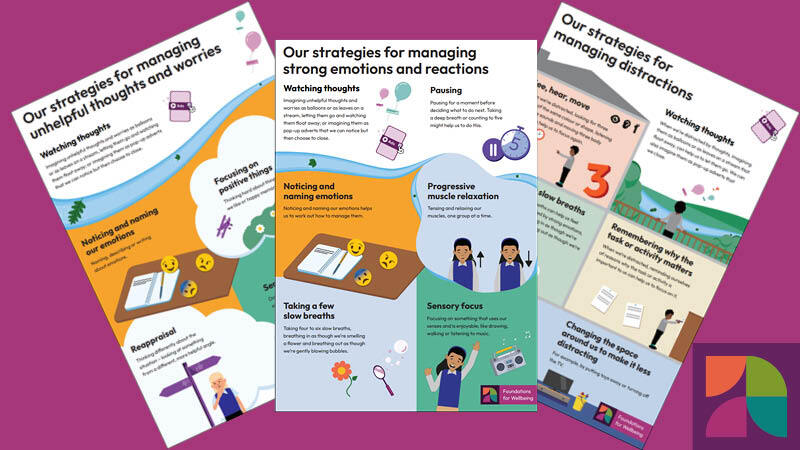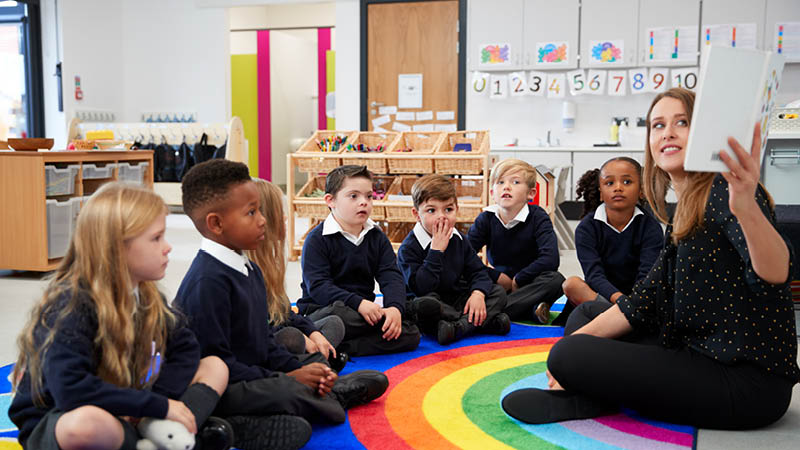Foundations for Wellbeing curriculum
A complete, evidence-based curriculum for teaching mental health and wellbeing in primary schools.
Support pupils aged 4–11 to understand and manage their emotions, attention and behaviour — with 35 fully-resourced lessons, practical strategies, and statutory RSHE coverage.
.png)
Mental health education in primary schools matters more than ever
There are significant concerns about children’s mental health. 2023 NHS Digital research showed that approximately one in six 8- to 10-year-olds in England had a probable mental disorder, and others may develop problems later on.
And unless addressed early on, we know these challenges can affect not only wellbeing but behaviour, attendance and learning — now and into adolescence.
PSHE education plays a vital role in prevention and support. But teaching this topic can feel daunting.
How can we ensure it’s:
🛡️ Safe and age-appropriate?
📚 Based on the latest evidence?
✅ Statutory-compliant and easy to implement?
You want to feel confident that you are doing right by your pupils and employing a fully researched, pedagogically sound approach that can support their wellbeing and attainment both now and in the future.
And you also need something that is practical, engaging and straightforward to implement, meeting statutory RSHE requirements within the curriculum time available for PSHE education.
Introducing Foundations for Wellbeing
Created in partnership with researchers at the University of York, led by Dr Dusana Dorjee, Foundations for Wellbeing is an innovative PSHE curriculum for 4–11 year olds that helps pupils learn to manage their emotions, attention and behaviour — with lifelong benefits for their wellbeing.
- 35 fully-resourced lessons – 5 per year group from EYFS to Year 6 – that you can plan seamlessly into your wider PSHE/RSHE curriculum (see lesson summary).
- Evidence-based self-regulation strategies that benefit learning and wellbeing.
- Sequenced progression to develop emotional literacy and regulation over time.
- Classroom-ready PowerPoints and pupil-facing materials, including videos and posters.
- Alignment with DfE statutory RSHE requirements for teaching about mental wellbeing.
- Exclusively available to School and School Plus members, with access to additional, on-demand CPD training available to School Plus members only.
This isn’t just a set of activities — it’s a groundbreaking curriculum that gives pupils lifelong strategies, and gives teachers the confidence to teach mental health education in a safe, supported and structured way.
You’ll be supporting better outcomes for pupils, and helping to create a calmer, more supportive classroom (and learning environment) for everyone.
We also have a secondary mental health and wellbeing curriculum available for members: Wellbeing for Life.
-
BSL version
-
BSL version

-
Each activity plan has been developed to support learning in the prime area of personal, social and emotional development (PSED) as part of the Early years foundation stage (EYFS) statutory framework. These plans provide early learning experiences to support children’s future PSHE education, and are precursory to the Foundations for Wellbeing lessons for key stage 1.
-
Learning objectives
PSHE Association Programme of Study
DfE statutory guidance
Year 1
Lesson 1: Noticing feelings
To learn about feelings.
Lesson 2: Distraction
To learn about distraction.
Lesson 3: Paying attention to pleasant feelings
To learn how to pay attention to pleasant feelings.
Lesson 4: Helpful and unhelpful thoughts
To learn about helpful and unhelpful thoughts.
Lesson 5: Reacting
To learn about different ways of reacting.
Year 2
Lesson 1: Noticing and naming feelings
To learn about thoughts and feelings and how noticing them can be helpful.
Lesson 2: Different distractions
To learn about different kinds of distraction.
Lesson 3: Changing thoughts and feelings
To learn about different ways of changing thoughts and feelings.
Lesson 4: Managing unhelpful thoughts
To learn how to manage unhelpful thoughts.
Lesson 5: Reactions and responses
To learn about ways of managing reactions and responses.
H12. how to recognise and name different feelings
H18. different things they can do to manage big feelings, to help calm themselves down and/or change their mood when they don’t feel good
H19. to recognise when they need help with feelings; that it is important to ask for help with feelings; and how to ask for it
H24. how to manage when finding things difficult
H27. about preparing to move to a new class/year group
Mental wellbeing
- that there is a normal range of emotions (e.g. happiness, sadness, anger, fear, surprise, nervousness) and scale of emotions that all humans experience in relation to different experiences and situations.
- how to recognise and talk about their emotions, including having a varied vocabulary of words to use when talking about their own and others’ feelings.
- where and how to seek support (including recognising the triggers for seeking support), including whom in school they should speak to […]
Respectful relationships, including friendships
- practical steps they can take in a range of different contexts to improve or support respectful relationships.
Year 3
Lesson 1: Exploring emotions
To learn about noticing thoughts, feelings and emotions, and how emotions vary in strength.
Lesson 2: Understanding distraction
To learn about different kinds of distraction and some ways they can be managed.
Lesson 3: Managing thoughts and emotions
To learn about helpful patterns of thoughts and emotions.
Lesson 4: Managing worries
To learn how to recognise and manage worry.
Lesson 5: Managing responses
To learn how feeling calm can help us to manage our responses.
Year 4
Lesson 1: Describing emotions
To learn how describing emotions and their intensity can help to manage them.
Lesson 2: Managing internal and external distractions
To learn about internal and external distractions and how they can be managed.
Lesson 3: Exploring different thinking habits
To learn about different ways of thinking and how this impacts wellbeing.
Lesson 4: Different ways to manage worries
To learn strategies that can help manage worries and positively impact emotions and behaviour.
Lesson 5: Strategies for calm
To learn strategies that can help someone manage their responses.
Year 5
Lesson 1: Noticing and naming emotions
To learn about managing thoughts and emotions in everyday situations.
Lesson 2: Directing attention and managing distractions
To learn about helpful and unhelpful distractions and strategies to manage them.
Lesson 3: Changing thinking habits
To learn about brain plasticity and how changing thinking habits can support wellbeing.
Lesson 4: Rumination and worry
To learn how changing the way someone thinks about an event can support wellbeing.
Lesson 5: Managing reactivity
To learn how managing reactivity can support wellbeing.
Year 6
Lesson 1: Regulating emotions
To learn how noticing and naming emotions can help someone to regulate them.
Lesson 2: Managing distraction
To learn a variety of strategies for managing internal and external distractions.
Lesson 3: Developing positive thinking habits
To learn about developing positive thinking habits and how this supports wellbeing.
Lesson 4: Manging rumination and worry
To learn about the impact of rumination and worry on emotions and behaviour, and strategies for managing rumination and worry.
Lesson 5: Managing stress
To learn about managing stress.
Programme of Study
H15. that mental health, just like physical health, is part of daily life; the importance of taking care of mental health
H16. about strategies and behaviours that support mental health – including how good quality sleep, physical exercise/time outdoors, being involved in community groups, doing things for others, clubs, and activities, hobbies and spending time with family and friends can support mental health and wellbeing
H17. to recognise that feelings can change over time and range in intensity
H18. about everyday things that affect feelings and the importance of expressing feelings
H19. a varied vocabulary to use when talking about feelings; about how to express feelings in different ways
H20. strategies to respond to feelings, including intense or conflicting feelings; how to manage and respond to feelings appropriately and proportionately in different situations
H21. to recognise warning signs about mental health and wellbeing and how to seek support for themselves and others
H29. about how to manage setbacks/perceived failures, including how to re-frame unhelpful thinking
H17. to recognise that feelings can change over time and range in intensity
H24. problem-solving strategies for dealing with emotions, challenges and change, including the transition to new schools
H35. about new opportunities and responsibilities that increasing independence may bring
H36. strategies to manage transitions between classes and key stages
On-Demand CPD courses
-
 Gain a sound understanding of the research and subject knowledge you need to support your pupils’ mental health and wellbeing.Learn more or enrol
Gain a sound understanding of the research and subject knowledge you need to support your pupils’ mental health and wellbeing.Learn more or enrol -
 Explore practical tips and pedagogical principles to help you teach this topic with confidence.Learn more or enrol
Explore practical tips and pedagogical principles to help you teach this topic with confidence.Learn more or enrol -
 Consider how to create and achieve a shared vision for mental health and wellbeing within your setting.Learn more or enrol
Consider how to create and achieve a shared vision for mental health and wellbeing within your setting.Learn more or enrol
Sign up to one of our multi-user membership packages to unlock our exclusive member benefits for your whole staff team:
- Full unrestricted access to all lesson plans
- Unlimited users in your school
- On-demand training (for School Plus users only)


